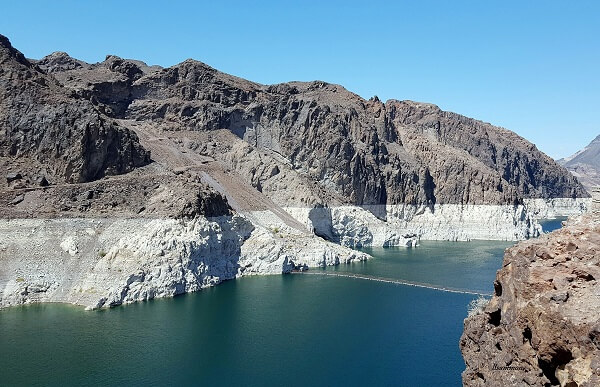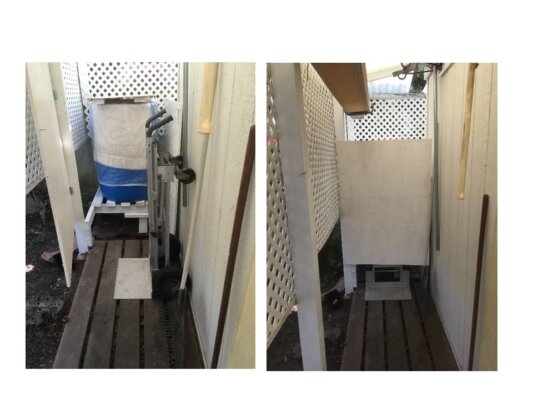
We have often repeated that “Preparedness is more a way of life than a list of stuff.” So over the past few days, in the face of ever more ominous threats of power outages and drought here in California, Joe and I took another look at our emergency water supplies.
- Liter bottles. Oh yes, we have bottles of water. A couple dozen liter bottles in the house, a half-dozen in each car, more in our storage shed. We go through them steadily, and replace as needed. (As we’ve mentioned before, we try to find square bottles. They pack so much better!)
- Bigger bottles. We also have sturdy half-gallon plastic bottles of water as back-up. I like the ones with indentations for handles.
- Empty containers. We have empty plastic jugs and bags to be filled at the last minute.
- Frozen water. And of course we have square plastic containers full of water in all our freezer compartments. They help with energy use and serve as yet another backup supply in the case of a power outage. (“Previously frozen” water does not really smell very appetizing but it would certainly work for hygiene.)
Today, we take another look at our 55 gallon water barrel.
Every preparedness list also includes the famous 55 gallon barrel. We have talked about these barrels many times over the years, since that one item would make a really big difference in emergency water supplies for most families!
How much is 55 gallons?
Well, if you use the standard measure of “1 gallon of water per person per day,” then your two-person family could get along for almost a month using water from a full barrel! A family of four could manage for at least a couple of weeks. Honestly, it just makes sense to have one – if you can afford it and can find a place for it.
What’s involved in having a 55 gallon water barred?
Here’s what we did this past week . . .
We’ve had our barrel for several years. It was part of a discounted group purchase made available to our Neighborhood Emergency Response Group. The price included the necessary hand pumps. (All the barrels were dropped off on one afternoon to our neighborhood. Volunteers then delivered them one by one to the people who had already paid. As it turns out, a barrel will NOT fit in an ordinary car or its trunk, so several people with trucks and/or golf carts ended up doing all the delivering.)
Our goal this week was to refresh the water in our own barrel and make a better place for storing it. In particular, we wanted it to be relatively invisible while still accessible.
First, build the platform.
Joe did a lot of measuring and cutting and painting and screwing to build a sturdy platform in this narrow space. “Sturdy” is the important word. The full barrel weighs nearly 500 pounds!

We positioned the platform at the corner of our shed, where it would be accessible from two sides. Then Joe cleverly added hinged “doors” so that the barrel itself, when in place, really isn’t visible.
Then, prepare the barrel.
In the meanwhile, I pulled that barrel down, cleaned the inside with a strong bleach solution, and rinsed it out to be refilled.
(Sorry I don’t have any photos. Imagine me rolling the barrel over and back on its side, with the bleach sloshing about loudly on the inside.)
Then we put the barrel up onto its new platform. Note: one person cannot manage a barrel, even an empty one! It’s not that it’s so heavy, but that there are no handles. We tried moving it using the hand truck you see in the photos. No – better to just carry it. But it is fat and extremely awkward! Get a friend to help!
Finally, fill the barrel.
I filled the barrel using the garden hose (carefully cleaned beforehand). Took 15-20 minutes. Added the proper amount of bleach to keep any nasties from growing inside. (See below for more on purifying the water.) Closed up the bung holes, covered the top, laid on a second, raised top to reflect sunlight and allow air to circulate, then stepped back to admire our work!
Voila! With the “door” closed, all you can see is the base of our hand truck, which fits in there very nicely, too!

If you’re inspired by our barrel, here are a few more guidelines to consider.
- Blue barrels can be pricey. (There are other colors, of course, but blue seems to be the standard.) On Amazon, where we’re Associates, you might find a price variation of as much as $40 for the same item! Be sure you shop and get what you want.
- You need a way to get the water out of the barrel once it is filled, so don’t forget a pump. (There are electric pumps available, but in an emergency you aren’t likely to have electricity . . .!)
- Be sure not to place your barrel right onto cement or concrete. Raise it up on a couple of boards, at least.
- Water doesn’t spoil. It’s the creepy-crawlies and dirt that get into it that make it unpalatable or even dangerous. Be sure you can seal the barrel tightly using a bung wrench. (For some reason holes in a cask or in the top of a barrel are called “bung holes” and the stoppers are called “bungs.”)
- Consider adding purifier for your long-term water supply. We used simple bleach. You may want to use liquid purifier, as shown below.
This looks like the best deal going right now.
We’ve shopped barrels for years. Right now, prices vary a lot. This package looked to be the best and most complete deal available on Amazon. Start your shopping here.

And a couple of additional resources for emergency water supplies:
https://emergencyplanguide.org/store-water-for-emergencies/ This Advisory goes into more detail about all kinds of water storage bottles, bags and bladders. Lots of pictures, ideas for storage, etc. It’s been recently updated, too (which is how we noticed some of the differences in pricing!)
https://amzn.to/3rvGWM0 This link takes you to our Mini-Book on water. It has close to 50 easy-to read pages on storing water now, before the emergency hits; how to find water AFTER the emergency hits and you’ve run out of your supplies; and dangers to watch out for. If you’re going to invest money in water, I’d recommend investing $5 in this little book first!
Walk the talk. Don’t overlook your water supplies. (Maybe you can get a discount deal on a bulk purchase, too!)
Virginia
Your Emergency Plan Guide team
Don't miss a single Advisory.
Thank you for subscribing.
Something went wrong.
